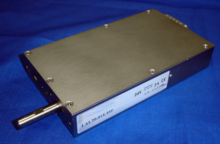Actuator
As actuator , also actuator (English: actuator ), usually are technical drive units referred to an electrical signal a physical (from the control computer commands issued) into mechanical movements or changes in variables such as pressure or temperature implement and thus actively interfere with the controlled process.
The associated technical discipline is actuator technology .
application areas
In measuring, control and regulation technology, actuators are the counterpart to sensors in relation to signal converters and form the final control elements in a control loop . During a control process, they convert the signals into effects - through mechanical work in motion control - with which the controlled variable is influenced. An example is opening and closing a valve or a ventilation flap.
In robotics , the term effector is often used synonymously instead of actuator . The last element of a kinematic chain is then also referred to as the end effector . In the case of a robot, this actuator or effector is used, for example, to grasp and process objects and thus creates an effect.
In sub-areas of mechatronics , such as actuators or linear technology , electromechanical drives , for example for lifting and adjustment systems, are used, which are generally referred to as actuators. The stepper motor of the read / write head of a hard disk or the compensating carriage for a stationary pendulum also represent an actuator. When controlling the process, a distinction is made between an open and a closed control loop .

Actor principles
- inductive electric motors
- Bimetal actuators
-
Hydraulic or pneumatic actuators
- z. B. Integrated Power Actuator (IPA)
- Cylinder ( pneumatic cylinder , hydraulic cylinder , electric cylinder )
- Electrochemical actuators
-
Electromechanical actuators
- Scotch-Yoke actuators (actuators based on the crank loop principle )
- Piezo actuator
- Magnetostrictive actuator
- Rheological actuator
- Shape Memory Alloy Actuators
- Electroactive polymer actuators
Developments in actuators that react to changes in certain environmental variables with defined actuator effects originate from the field of new materials. You can use it to replace electrical control systems with a single element. Actuators based on shape memory alloys and expansion elements are temperature-sensitive and are used in temperature controllers, for example . Shape memory alloy actuators create new possibilities and offer advantages u. a. in terms of installation space and weight, e.g. For example, flat bending actuators in which shape memory alloy wires are integrated into a fiber-reinforced plastic composite can achieve a deflection in the range of a few millimeters to several centimeters, depending on their size.
Smart hydrogels are used, among other things, for chemostats that automatically regulate pH , ion or substance concentrations .
See also
literature
- Daniel J. Jendritza: Technical use of new actuators . expert, Renningen 2008, ISBN 978-3-8169-2765-5 .
- H. Janocha: Actuators - Basics and Applications . Springer, Berlin 2004, ISBN 3-540-61564-4 .
- Clarence W. De Silva: Sensors and actuators - control systems instrumentation . CRC Pr., Boca Raton 2007, ISBN 978-1-4200-4483-6 .
- John R. Brauer: Magnetic actuators and sensors . Wiley-Interscience, Hoboken 2006, ISBN 0-471-73169-2 .
- Actuators - machines modeled on muscles . In: Naturwissenschaftliche Rundschau . No. 12 , 2005, ISSN 0028-1050 , p. 654 .
- B. Schröer: Actuators in microsystem technology. In: Sensor magazine. 1992, ISSN 0179-9592 , No. 1, 23-25, No. 2, pp. 10-13.
Web links
Individual evidence
- ↑ Foil-based miniature actuator: "Crocodile" with shape memory. February 26, 2018, accessed June 27, 2019 (German).
- ↑ Shape memory actuators enable new freedom with minimal installation space and minimal weight. Retrieved November 22, 2019 .
